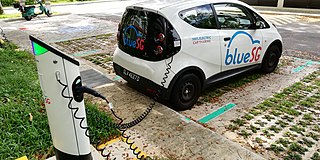
A patent is a type of intellectual property that gives its owner the legal right to exclude others from making, using, or selling an invention for a limited period of time in exchange for publishing an enabling disclosure of the invention. In most countries, patent rights fall under private law and the patent holder must sue someone infringing the patent in order to enforce their rights. In some industries patents are an essential form of competitive advantage; in others they are irrelevant.

A non-renewable resource is a natural resource that cannot be readily replaced by natural means at a pace quick enough to keep up with consumption. An example is carbon-based fossil fuels. The original organic matter, with the aid of heat and pressure, becomes a fuel such as oil or gas. Earth minerals and metal ores, fossil fuels and groundwater in certain aquifers are all considered non-renewable resources, though individual elements are always conserved.

A renewable resource, also known as a flow resource, is a natural resource which will replenish to replace the portion depleted by usage and consumption, either through natural reproduction or other recurring processes in a finite amount of time in a human time scale. When the recovery rate of resources is unlikely to ever exceed a human time scale, these are called perpetual resources. Renewable resources are a part of Earth's natural environment and the largest components of its ecosphere. A positive life-cycle assessment is a key indicator of a resource's sustainability.

Environmental technology (envirotech), green technology (greentech) or clean technology (cleantech) is the application of one or more of environmental science, green chemistry, environmental monitoring and electronic devices to monitor, model and conserve the natural environment and resources, and to curb the negative impacts of human involvement. The term is also used to describe sustainable energy generation technologies such as photovoltaics, wind turbines, etc. Sustainable development is the core of environmental technologies. The term environmental technologies is also used to describe a class of electronic devices that can promote sustainable management of resources.

The National Energy Technology Laboratory (NETL) is a U.S national laboratory under the Department of Energy Office of Fossil Energy. NETL focuses on applied research for the clean production and use of domestic energy resources. NETL performs research and development on the supply, efficiency, and environmental constraints of producing and using fossil energy resources, while maintaining their affordability.

Clean technology, in short cleantech, is any process, product, or service that reduces negative environmental impacts through significant energy efficiency improvements, the sustainable use of resources, or environmental protection activities. Clean technology includes a broad range of technology related to recycling, renewable energy, information technology, green transportation, electric motors, green chemistry, lighting, grey water, and more. Environmental finance is a method by which new clean technology projects can obtain financing through the generation of carbon credits. A project that is developed with concern for climate change mitigation is also known as a carbon project.
Tyler Jay Hamilton is a Canadian author, cleantech expert and former business and technology reporter specializing in clean technology. He is currently Director of Cleantech at MaRS Discovery District, and a former Adjunct Professor at York University's Faculty of Environmental Studies. Previously, Hamilton was Editor-in-Chief of Corporate Knights magazine, and Climate and Economy Reporter with the Toronto Star, Canada's largest daily-circulation newspaper.
Renewable Fuels are fuels produced from renewable resources. Examples include: biofuels and Hydrogen fuel. This is in contrast to non-renewable fuels such as natural gas, LPG (propane), petroleum and other fossil fuels and nuclear energy. Renewable fuels can include fuels that are synthesized from renewable energy sources, such as wind and solar. Renewable fuels have gained in popularity due to their sustainability, low contributions to the carbon cycle, and in some cases lower amounts of greenhouse gases. The geo-political ramifications of these fuels are also of interest, particularly to industrialized economies which desire independence from Middle Eastern oil.
The Office of Energy Efficiency and Renewable Energy (EERE) is an office within the United States Department of Energy. Formed from other energy agencies after the 1973 energy crisis, EERE is led by the Assistant Secretary of Energy Efficiency and Renewable Energy, who is appointed by the President of the United States and confirmed by the U.S. Senate. Kelly Speakes-Backman was appointed Acting Assistant Secretary in January 2021.

Renewable energy commercialization involves the deployment of three generations of renewable energy technologies dating back more than 100 years. First-generation technologies, which are already mature and economically competitive, include biomass, hydroelectricity, geothermal power and heat. Second-generation technologies are market-ready and are being deployed at the present time; they include solar heating, photovoltaics, wind power, solar thermal power stations, and modern forms of bioenergy. Third-generation technologies require continued R&D efforts in order to make large contributions on a global scale and include advanced biomass gasification, hot-dry-rock geothermal power, and ocean energy. As of 2012, renewable energy accounts for about half of new nameplate electrical capacity installed and costs are continuing to fall.

The United States produced 6.6 billion metric tons of carbon dioxide equivalent greenhouse gas (GHG) emissions in 2019, the second largest in the world after greenhouse gas emissions by China and among the countries with the highest greenhouse gas emissions per person. In 2019 China is estimated to have emitted 27% of world GHG, followed by the United States with 11%, then India with 6.6%. In total the United States has emitted a quarter of world GHG, more than any other country. Annual emissions are over 15 tonnes per person and, amongst the top eight emitters, is the highest country by greenhouse gas emissions per person. Because coal-fired power stations are gradually shutting down, in the 2010s emissions from electricity generation fell to second place behind transportation which is now the largest single source. In 2019, 29% of the GHG emissions of the United States were from transportation, 25% from electricity, 23% from industry, 13% from commercial and residential buildings and 10% from agriculture. These greenhouse gas emissions are contributing to climate change in the United States as well as worldwide.

Biobased economy, bioeconomy or biotechonomy is economic activity involving the use of biotechnology and biomass in the production of goods, services, or energy. The terms are widely used by regional development agencies, national and international organizations, and biotechnology companies. They are closely linked to the evolution of the biotechnology industry and the capacity to study, understand, and manipulate genetic material that has been possible due to scientific research and technological development. This includes the application of scientific and technological developments to agriculture, health, chemical, and energy industries.

The Clean Tech Revolution: The Next Big Growth and Investment Opportunity is a 2007 book by Ron Pernick and Clint Wilder, who say that commercializing clean technologies is a profitable enterprise that is moving steadily into mainstream business. As the world economy faces challenges from energy price spikes, resource shortages, global environmental problems, and security threats, clean technologies are seen to be the next engine of economic growth.
The environmental benefits of renewable energy technologies are widely recognised, but the contribution that they can make to energy security is less well known. Renewable technologies can enhance energy security in electricity generation, heat supply, and transportation.
Renewable energy law is a particular kind of energy law, and relates primarily to the transactional legal and policy issues that surround the development, implementation, and commercialization of renewable sources of energy, such as solar, wind, geothermal and tidal. Renewable energy, (RE) law also relates to the land use, siting, and finance issues encountered by developers of renewable energy projects.
New Energy for America was a plan led by Barack Obama and Joe Biden beginning in 2008 to invest in renewable energy sources, reduce reliance on foreign oil, address global warming issues, and create jobs for Americans. The main objective for the New Energy for America plan was to implement clean energy sources in the United States in order to switch from nonrenewable resources to renewable resources. The plan led by the Obama Administration aimed to implement short-term solutions to provide immediate relief from pain at the pump, and mid- to- long term solutions to provide a New Energy for America plan. The goals of the clean energy plan hoped to: invest in renewable technologies that will boost domestic manufacturing and increase homegrown energy, invest in training for workers of the clean technologies, strengthen the middle class, and help the economy.

Viaspace is a clean energy company focused on commercializing technologies from NASA, Caltech, University of Southern California and the United States Department of Defense. The company operates in the alternative energy, renewable energy, and chemical sensing sectors. The company is associated with the Jet Propulsion Lab (JPL) and the California Institute of Technology through its CEO, Dr. Carl Kukkonen.
Cleantech Finland is a Finnish national project, backed by the Government of Finland and created as part of Finland’s National Action plan to develop the country’s environmental business. The network aims to bring together expertise from Finland's clean technology industry and research and to support clean technology companies internationally. Cleantech Finland is owned by the Confederation of Finnish Industries.

LA Cleantech Incubator (LACI) is the City of Los Angeles's official cleantech business incubator established to accelerate the commercialization of clean technology and job creation in the Los Angeles region. LACI's staff of entrepreneurs, market specialists, and researchers combined with its 60+ mentor/advisor network provide expert advice on a full range of issues facing early to growth stage companies, including CEO coaching, financial modeling, business development, IP, and more. The organization is run "by entrepreneurs, for entrepreneurs" and pursues public objectives by harnessing private methods and resources. In 2014, LACI was ranked by UBI Global as the Number 6 university-affiliated business incubator in the world out of 800+ incubators in 67 countries.

John O'Brien is an English businessman and an expert advisor to Australian governments and the cleantech sector. He is a Partner with Deloitte Financial Advisory and leads the firm's Energy Transition and Decarbonisation work in Australia. He was formerly the managing director of Australian CleanTech which acted as the Australian representative for the Global CleanTech Cluster Association. He was also a non-executive director of Novarise Ltd, an ASX listed company which recycles polypropylene waste in China. O'Brien entered the Australian energy sector in the 1990s and worked for Origin Energy for nine years. He had previously worked in the Middle East, the United Kingdom and Canada where he held various oil and gas industry and consulting engineering roles. O'Brien lectured in leadership and entrepreneurship at the University of Adelaide and was a member of the Premier’s Climate Change Council in South Australia. He has been a member of the board of several CleanTech companies involved in wind farm development, biosensors and plastic recycling. He has served on the board of Renewables SA and as a member of the Clean Technology Innovation Program Committee at Innovation Australia. O'Brien has studied at Oxford, Trinity College in Dublin and the University of Adelaide from which he has received two engineering degrees and an MBA respectively.













